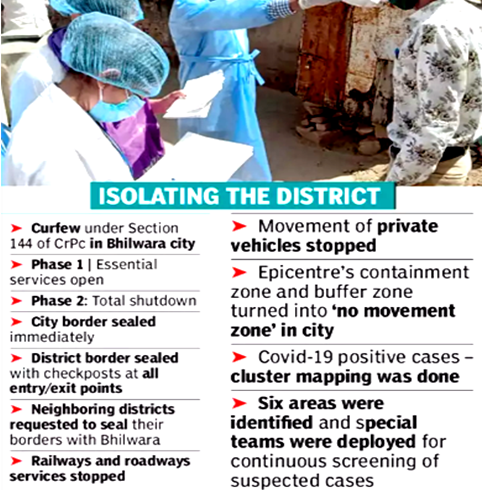Bhilwara Model: Coping With COVID-19
- 07 Apr 2020
- Almost two weeks into the nationwide lockdown, with the case count from the novel coronavirus disease still soaring up, the government is now looking forward to adopt the Bhilwara model as a containment strategy to curb the spread of new coronavirus in areas that have been identified as hotspots.
- Bhilwara in Rajasthan was one of the early hotspots of the COVID-19 outbreak. The containment strategy was found to be successful in Bhilwara, and since then health officials in both Rajasthan and the Centre have been unofficially terming this specific containment plan as the “Bhilwara model”.
About Bhilwara Model of COVID-19 Containment
- It refers to the steps taken by the administration in Rajasthan’s Bhilwara district to contain the disease, after it emerged as a hotspot for coronavirus positive cases.
Strategies Adopted under the Model
- The Bhilwara model of containment worked in phases.
- The first task was to isolate the district, second was screening strategy in city and rural areas and third was quarantine and isolation wards, followed by monitoring mechanism for rural areas.
Ruthless Containment
- District and state-level officials toiled hard to ensure that community or cluster spread of the novel coronavirus, which would have wrecked havoc, did not happen in Bhilwara. For this, the state government deployed 3000 teams of health workers in the district.
- For isolating the district, curfew was imposed in the district on the day the first case was reported. This was from March 20 to April 2, 2020.
- During this period, essential services were exempted from the order.
- Door to, door survey was started in order to map the positive cases, followed by the contact tracing.
- The administration defined the containment zone of one km from the epicenter – the private hospital, whose doctors and staffs were the first ones to test positive – and a buffer zone of three km. Similar, containment and buffer zones were also created around the house of a positive patient.
- A screening and testing centre was established at a hospital, which was dedicated as COVID hospital.
- During this time, disinfection of the following was done on a daily basis: containment zone and buffer zone; locality of positive cases; all ambulances and police vehicles; screening centre and quarantine centre; collectorate, police line and public dealing offices; and city wards.
Borders Sealed
- On the administrative front, strict measures were undertaken. The immediate step was to seal the boundaries and impose a curfew in entire city.
- The district administration then acquired all hotels in the district and brought it under its jurisdiction. These hotels were turned into quarantine centres where nearly a thousand people were quarantined.
Total Lockdown
- Meanwhile, lockdown restrictions, which were place since March 20, were tightened to curfew-like levels from April 3. Between March 20 and April 2, stores selling essential commodities were allowed to stay open.
- However, on April 3, 2020, even these stores were ordered shut and only home delivery of essentials is currently allowed. And, nobody was permitted to venture out of their homes without prior permission.
 Source: ToI
Source: ToI
Challenges Faced by the Administration
- The biggest challenge that the administration faced was containing the rising number of cases after the initial outbreak.
- After the first case of COVID-19 was detected in the district, several other cases, mostly contact of the doctors and the infected hospital staff were reported with each passing day.
- The government also had an uphill task ahead of them assembling the teams of doctors, auxiliary nurse and midwives and nursing students who went to conduct the house-to-house surveys.
- Owing to the fact that Bhilwara, a thriving textile city with an estimated population of 30 lakh, it was also a difficult task for the government to strictly impose the curfew uniformly in all areas.
Implementing Bhilwara Model across the Country
- The government has drawn a plan for containment of the virus in hotspots based on the steps taken in Bhilwara.
- Geographical areas will be quarantined under this model.
- Clusters of infections will be identified within the quarantined area and steps, which were taken in Bhilwara, will be taken in these clusters.
- The Disaster Management Act of 2005 and the Epidemic Diseases Act of 1897 can be used to implement the model. CrPc and IPC sections can be used to book violators.
- People will be checked for influenza-like symptoms. They will be monitored actively and tested.
Way Forward
- India’s fight against COVID-19 can only be tackled if it is decentralised down to the unit level and policy-makers let specific geographies and local dynamics decide how things could work best at a cluster.
- The non-pharmaceutical intervention is the best way to contain the crisis given India’s non-existent health infrastructure and Bhilwara has shown how to bring the virus out of hiding.
- The faster we do it, the easier it will be for us to get back on the road to recovery and get the economy going.

